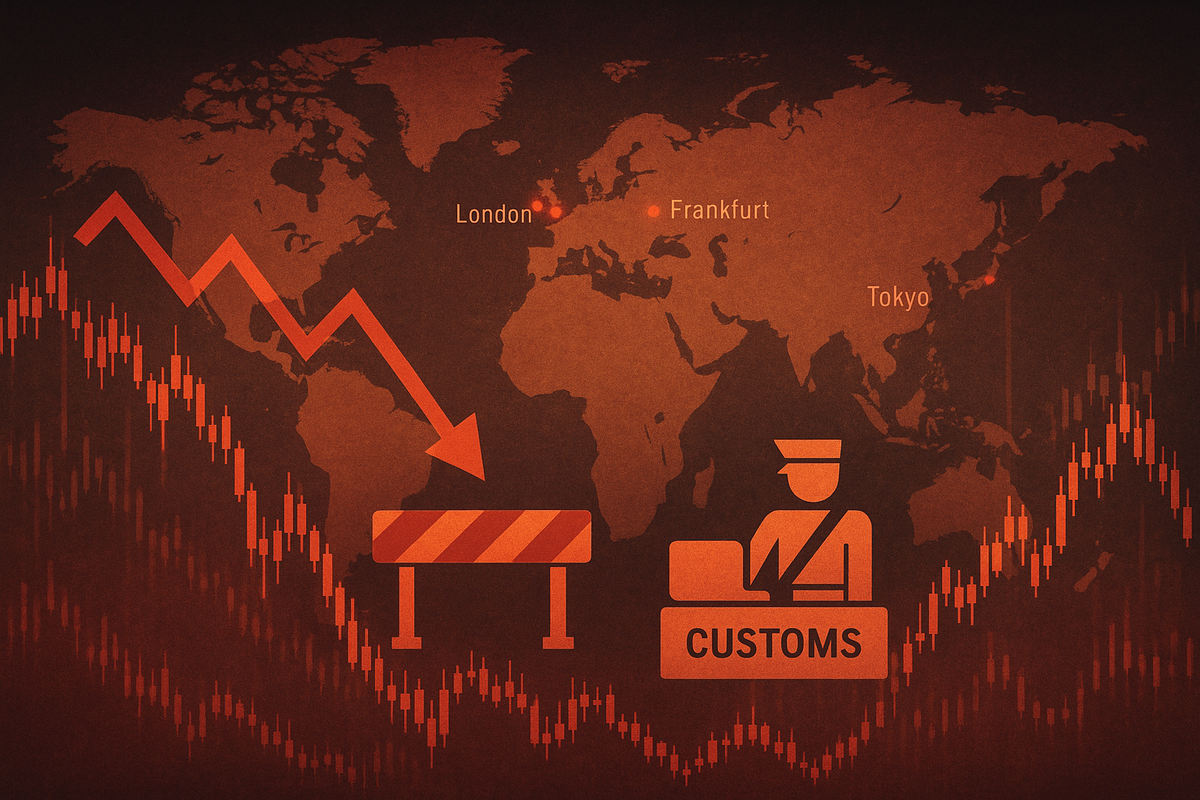
Global financial markets are currently navigating a turbulent landscape, marked by pervasive volatility driven by escalating tariff tensions, particularly from the United States, and mounting concerns over a global economic slowdown. This confluence of factors has injected a significant degree of uncertainty into investor sentiment, leading to cautious trading and influencing overall market trends. The current environment echoes historical periods of economic and trade friction, prompting market participants to re-evaluate strategies and brace for potential shifts.
The Unfolding Storm: Tariffs and Economic Headwinds Take Center Stage
The current market instability is largely a direct consequence of renewed protectionist policies and a series of weaker-than-expected economic indicators from major global economies. The Trump administration, which began its second term in January 2025, has aggressively pursued a strategy of imposing higher tariffs, significantly impacting international trade flows and corporate supply chains.
The timeline of recent trade developments paints a clear picture of escalating tensions. In February 2025, President Trump signed an executive order imposing a 10% tariff on all Chinese imports, effective February 4, and 25% tariffs on most imports from Canada and Mexico. This was swiftly followed by retaliatory tariffs from China. Further escalations in March and April saw the US announce plans to hike steel and aluminum tariffs to a flat 25%, introduce a 25% tariff on imported cars and light trucks, and proclaim global tariffs with a baseline of 10% across all imports, with significantly higher duties on some countries, including a 34% tariff on all Chinese imports. China responded in kind, leading to a tit-for-tat exchange that saw tariffs on Chinese imports from the US reach 125% and Chinese tariffs on American goods rise to 84% at one point. While a temporary reduction in reciprocal tariffs was agreed upon in May, bringing the effective tariff rate on Chinese imports to 30% and Chinese tariffs on American goods to 10%, the underlying tensions remain. As of August 1, nearly 70 countries face Trump's import duties, with most delayed until August 7, and a 30% combined tariff is set to be applied between the US and China following an agreed pause until August 12.
Key players in this unfolding drama include the governments of the United States, China, Canada, Mexico, and the European Union, all of whom are directly impacted by these trade policies. Central banks, such as the Federal Reserve (US), the People's Bank of China (PBOC), and the European Central Bank (ECB), are also closely monitoring the situation, with their monetary policy decisions influencing currency movements and market sentiment.
Initial market reactions have been pronounced. US stock indices lost trillions in market value within days of new tariffs being introduced in April 2025, with the S&P 500 (NYSEARCA: SPY) and Nasdaq (NASDAQ: QQQ) experiencing pullbacks due to weaker economic data and escalating trade tensions. Chinese and European stocks have also fallen in response to the tariffs. Currency markets have seen significant volatility, with the US Dollar (USD) generally strengthening amidst uncertainty, while the Chinese Yuan (CNY) has weakened. Commodity prices, particularly for metals like copper and aluminum, and agricultural products like soybeans, have been directly impacted, experiencing price fluctuations and disrupted trade flows.
Navigating the Crosscurrents: Winners and Losers in a Tariff-Laden World
The current environment of escalating tariffs and economic slowdown fears is creating a distinct divide between potential winners and losers across various sectors and companies.
Potential Losers:
Companies heavily reliant on global supply chains and international trade are particularly vulnerable. Multinational corporations with significant manufacturing operations or sales in countries targeted by tariffs face increased input costs, reduced profitability, and potential supply chain disruptions. For instance, Apple Inc. (NASDAQ: AAPL), with its extensive manufacturing presence in China, could see higher production costs and reduced demand if tariffs on consumer electronics escalate further. Similarly, Ford Motor Company (NYSE: F) and General Motors Company (NYSE: GM), which import vehicles and parts, are directly impacted by tariffs on imported cars and steel, leading to higher production costs and potentially higher prices for consumers, which could dampen sales.
Sectors with high exposure to international trade, such as automotive, electronics, and agriculture, are also feeling the pinch. US farmers, particularly soybean producers, have been significantly hurt by China's retaliatory tariffs, forcing them to seek alternative markets and accept lower prices. Companies like Archer-Daniels-Midland Company (NYSE: ADM) and Bunge Limited (NYSE: BG), major agricultural commodity traders, face reduced volumes and margins in key markets.
Furthermore, companies with substantial debt loads may find it harder to navigate an economic slowdown, as tighter credit conditions and reduced consumer spending could impact their ability to service debt and invest in growth.
Potential Winners:
While the overall sentiment is cautious, some sectors and companies may find themselves in a relatively advantageous position. Domestic manufacturers in countries imposing tariffs could see increased demand for their products as imported goods become more expensive. For example, US steel producers like United States Steel Corporation (NYSE: X) and Nucor Corporation (NYSE: NUE) could benefit from higher domestic demand and reduced competition from imports due to steel tariffs.
Companies with strong domestic supply chains and less reliance on international trade may also be more resilient. Businesses that can quickly adapt their supply chains or shift production to avoid tariffs could gain a competitive edge. Additionally, companies in essential services or defensive sectors, such as utilities and healthcare, tend to be less susceptible to economic downturns and trade disputes, offering a degree of stability to investors.
Furthermore, some companies might benefit from strategic shifts in global trade. For example, if companies diversify their supply chains away from China, countries like Vietnam, Mexico, or India could see increased foreign direct investment, benefiting local industries and companies.
Broader Implications: Reshaping Global Commerce and Policy
The current trade tensions and economic slowdown fears are not isolated events; they represent a significant inflection point that is reshaping broader industry trends, triggering ripple effects across global supply chains, and prompting a re-evaluation of regulatory and policy frameworks.
This event fits into a broader trend of deglobalization or "slowbalization," where the interconnectedness of the global economy is being challenged by protectionist policies and geopolitical considerations. Companies are increasingly looking to diversify their supply chains away from single points of failure, particularly China, leading to a potential restructuring of global manufacturing and trade routes. This could accelerate the trend of reshoring or nearshoring, where production is brought back closer to home markets or to neighboring countries.
The ripple effects are profound. Competitors and partners are being forced to adapt rapidly. Companies that previously relied on cost-effective production in China are now exploring alternative sourcing strategies, which could lead to higher production costs in the short term but greater supply chain resilience in the long run. This also creates opportunities for countries not directly involved in the tariff disputes to attract new investments and become alternative manufacturing hubs.
Regulatory and policy implications are also significant. Governments are under pressure to support domestic industries impacted by tariffs, potentially through subsidies or other forms of aid. There's also a growing debate about the role of international trade organizations like the World Trade Organization (WTO) in resolving disputes and enforcing trade rules in an increasingly fragmented global economy. The current situation could lead to a weakening of multilateral trade agreements and a rise in bilateral trade deals.
Historically, periods of heightened trade protectionism have often been associated with economic downturns. The Great Depression of the 1930s, for example, was exacerbated by the Smoot-Hawley Tariff Act, which led to retaliatory tariffs from other countries and a sharp decline in global trade. While the current situation is not directly comparable in scale, the historical precedent serves as a cautionary tale, highlighting the potential for trade wars to undermine global economic growth and stability. The current environment also draws parallels to the trade disputes of the 1980s between the US and Japan, which led to significant shifts in industries like automotive and electronics.
What Comes Next: Navigating Uncertainty and Seizing Opportunities
The path forward for global markets remains uncertain, with both short-term challenges and long-term possibilities emerging from the current environment of tariff tensions and economic slowdown fears.
In the short term, markets are likely to remain volatile, reacting sharply to every new development in trade negotiations and economic data releases. Companies will continue to grapple with increased costs, supply chain disruptions, and reduced demand in certain sectors. Investors should anticipate continued fluctuations in stock indices, currency markets, and commodity prices. Central banks will be closely watched for their responses, with potential interest rate adjustments aimed at stabilizing economies.
Long-term possibilities include a significant restructuring of global supply chains, with companies prioritizing resilience and diversification over pure cost efficiency. This could lead to increased investment in automation and advanced manufacturing technologies to reduce reliance on labor in specific regions. There's also the potential for new trade blocs and alliances to emerge as countries seek to secure their economic interests in a more fragmented global trade landscape.
Strategic pivots and adaptations will be crucial for businesses to thrive. Companies may need to re-evaluate their global footprint, explore new markets, and invest in research and development to create innovative products and services that are less susceptible to trade barriers. Diversifying sourcing, building regional supply chains, and focusing on domestic market opportunities will become increasingly important.
Despite the challenges, market opportunities may emerge. Companies that can offer solutions for supply chain resilience, such as logistics and warehousing services, or those that specialize in automation and advanced manufacturing, could see increased demand. Furthermore, domestic industries that benefit from reduced foreign competition due to tariffs may experience growth. Investors might also find opportunities in defensive sectors or companies with strong balance sheets and stable cash flows that can weather economic storms.
Potential scenarios range from a de-escalation of trade tensions through negotiated agreements, leading to a rebound in global trade and economic growth, to a prolonged period of protectionism and economic fragmentation, which could result in slower global growth and increased inflation. Another scenario involves a "new normal" where trade is more regionalized and less interconnected, requiring businesses to adapt to a more complex and less predictable global environment.
Conclusion: A New Era of Global Trade and Investment
The current period of global market volatility, driven by escalating tariff tensions and economic slowdown fears, marks a significant turning point in the landscape of international trade and investment. The immediate implications are clear: increased costs for businesses, disrupted supply chains, and a cautious sentiment among investors.
The key takeaway from this event is the growing emphasis on resilience and adaptability in global commerce. Companies can no longer rely solely on optimized, just-in-time global supply chains; they must build in redundancies and diversify their operations to mitigate geopolitical risks. The shift towards regionalization and nearshoring is likely to accelerate, reshaping manufacturing footprints and trade routes for years to come.
Moving forward, the market will be characterized by continued uncertainty, but also by new opportunities for those who can strategically pivot. Investors should closely monitor developments in trade negotiations, economic data from major economies, and the policy responses of central banks. Companies with strong balance sheets, diversified revenue streams, and agile supply chains will be better positioned to navigate the turbulent waters.
Ultimately, this period of heightened volatility is not merely a temporary blip; it represents a fundamental re-evaluation of globalization and the emergence of a new era of global trade and investment, one that prioritizes national interests and supply chain security alongside economic efficiency. The lasting impact will be a more fragmented yet potentially more resilient global economy, demanding strategic foresight and adaptive capabilities from all market participants.




